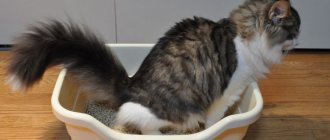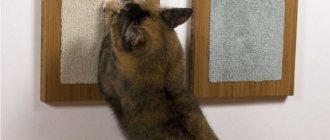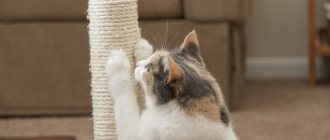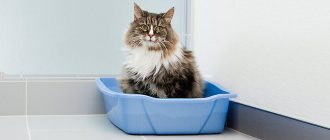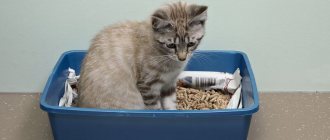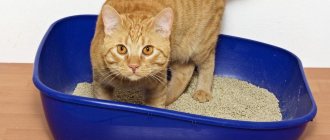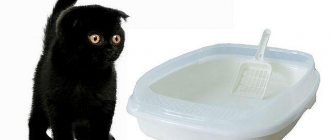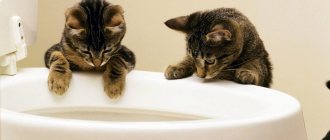The rather banal phrase “animals are a responsibility” sometimes simply flies out of your head when you see funny kids. And when purchasing a kitten, many new owners are not prepared for the fact that it needs to be fed regularly, properly cared for and taken into account its other needs, including physiological ones. A pet is not a toy and must also go to the toilet. And taking into account the fact that they are taken away from their mother at a fairly young age, you will have to take it upon yourself to teach him to relieve his natural needs in a certain place. If an animal is brought in from the street, you will also have to worry about how to teach it to behave correctly with people.
Quarantine
Of course, the reaction of an old-timer to a young guest in the form of hissing, growling, snorting and fur standing on end is quite natural.
Therefore, usually, when bringing a kitten into the house, he is not introduced to the cat right away. And they do it gradually. At first, the pets are placed separately. Some animal psychologists recommend placing the cat and kitten in different but adjacent rooms, and covering the doorway with mesh. This way the pets will feel each other, but will not touch each other. If desired, they can always communicate. Bowls should be placed on both sides of the net, in which there should always be water and food - the cats will be kinder and more accommodating. In order for animals to quickly get used to new smells, it is recommended to change places, but still keep them isolated. After about a week, when the pets get used to it and are no longer afraid, they can be released. But they should still be under the supervision of the owner. Any undesirable behavior towards a neighbor - a blow with a paw, hissing - should be stopped. However, repeated isolation is only required if the animals begin to fight (not to be confused with play). In case of an aggressive reaction, the animals are again divided for the same period. Then the introduction is repeated.
We accustom the cat to the litter
Previously, we made a brief overview of the types of fillers. But in order for a cat to start using the toilet, you need to accustom it to it. Sometimes the absorbent itself plays a big role. Some cats do not accept silica gel fillers, while others always use them. If the cat does not approach the tray with the new litter, try to show him with raking movements that this product can be used for his needs.
When you accustom a kitten to the litter, results can be achieved faster. In order for the baby to understand where to go to the toilet, it is enough to take him to the tray after feeding. In small furry pets, the body is designed in such a way that after eating there is a natural desire to urinate.
If you want to accustom an adult cat to a new litter, you will have to spend a little more time. Your pet can be picky, and you shouldn’t scold her for that. The fact is that the lumps of filler can be either too large or small. Also, sometimes a cat's sensitive pads perceive them as too sharp. It happens that the whims of an animal are associated with odor, which can arise not only from the components of the filler. Typically, when the litter box is in the bathroom, where other scents are present, the cat's scent receptors may be irritated.
In order for your pet to start using the tray with the new filler, create comfortable conditions. The toilet can be located in the restroom, on the balcony or in the corridor.
Reasons for sloppiness
Everything is clear with a small kitten; he still doesn’t know how to do everything right. But why does a previously tidy cat begin to mark everything and abandon its nested tray? The reasons may be different:
- If a cat begins to go to the owner's bed , or a cozy soft rug, the reason for this may be pain when urinating, which the animal begins to associate with the litter box. In this case, you need to show your pet to a veterinarian.
- The fluffy little ball learned to be neat, and when he grew up a little, he completely forgot about hygiene. Congratulations, your pet has matured and started marking its territory . The most reliable remedy in this case is castration or sterilization.
- Stress can also cause untidiness. It can be caused by the arrival of a new family member, a change of environment, moving, buying new furniture, or if the cat is scared away from the litter box.
How to toilet train a kitten: quickly and easily
Where to start if you need to toilet train a kitten? What are the features of studying in an apartment and in a private house? What to do if a kitten asks to go outside to the toilet. Let's consider the nuances of training a tray with or without filler. For especially patient and demanding owners - instructions on how to teach a kitten to go to the toilet in the toilet.
Absolutely all pets want to please their owner, receive praise and well-deserved attention. If the kitten begins to ignore the toilet, despite punishments and your dissatisfaction, something is clearly wrong with him
Perhaps training will help correct the situation, during which the kitten clearly understands what actions are prohibited.
Toilet training a kitten in an apartment
A cat can be toilet trained regardless of age. Moreover, adult cats understand much faster what exactly is wanted from them, while kittens act instinctively. If you live in an apartment, the easiest way to toilet train a kitten is to use an algorithm that has been proven over the years.
On the day of moving to a new home, carefully monitor your pet and take him to the litter box every time he starts meowing, getting agitated, or digging on the floor. Wait patiently and return your pet to the litter box until he relieves himself. The scent left in the litter box will serve as a guide for your pet in the future.
Important! If the moment was missed and the kitten went to the toilet on the floor, you need to take a moisture-absorbing diaper or napkin and blot the “traces of the crime.” Afterwards, the napkin that has a smell must be placed in the tray and sprinkled with filler
Toilet training a kitten in a private home
When living in a private house, several conventions or problems may arise. If a kitten is picked up on the street, it may instinctively strive to relieve itself in the yard.
If you are ready to constantly monitor your pet, this option is quite acceptable. However, if you cannot guarantee the kitten’s safety outside, it must be trained to use the toilet in the house.
The training algorithm is similar to the above.
Tip: to make training more effective, allocate one room for the kitten, place a tray, bowls, house and all the pet’s personal belongings in it. When all the necessary accessories are located within the baby’s reach, the likelihood of “misses” with the toilet is much reduced.
How to train a kitten to use the litter box if it asks to go outside to the toilet?
What to do if a kitten persistently asks to go outside to the toilet? Most likely, the reason for this behavior of the pet is in the tray filler. Outdoor kittens get used to peeing in the ground and may be afraid to dig in the sand or feel uncomfortable. The problem is solved!
We buy soil at a hardware store and a tray to fill with it. You will quickly see that soil is not the most suitable filler, since it does not absorb odor and quickly becomes wet.
For the first few days, just for the sake of accustoming the kitten to a certain tray or place to relieve itself, use only soil as a filler.
Afterwards, when the kitten begins to confidently navigate where to run to the toilet, start mixing the litter you have chosen for the tray into the soil.
Training a one-month-old kitten in 1 day
Observing the behavior and needs of a one-month-old kitten on the first day in a new home makes it possible to accustom him to the litter box in 1 day. At one month of age, kittens experience the urge to empty their bowels and bladder within 5-20 minutes after eating or drinking water.
Immediately after feeding, it is necessary to observe the kitten and transfer it to the tray as soon as it begins to worry. Keep an eye on the kitten and return it to the litter box until it relieves itself. Praise the kitten generously and repeat this algorithm after each feeding.
If you need a distraction, isolate the kitten in a carrier. A healthy animal will not go to the toilet under itself! Once you have released the kitten from the carrier, transfer it to the litter box and wait for 10-20 minutes, perhaps it will go to the toilet. To increase the effectiveness of training, use a spray to train kittens to the tray.
If you're very concerned about preserving your property but don't have the time to train a kitten, it may be wiser to consider an alternative:
- The first option is to purchase a kitten older than 3 months.
- The second alternative is to adopt a kitten from a volunteer.
Let's figure out how to train a kitten, depending on the type of pet toilet that will be convenient for you. In essence, all algorithms are very similar, but they work differently, since the temperament and habits of animals are very individual.
Why does a cat eat litter?
There are times when a new furry family member appears in the house: a cat or cat. The owner tries to provide the pet with everything necessary: he selects food that the animal eats with pleasure, a comfortable bed and a tray with good filling. Days pass, the animal settles into new conditions, the owner hears a characteristic rustling in the toilet, comes in to praise the cat, and the cat, instead of doing its business in the litter box, shamelessly eats the litter.
This can happen for several reasons:
- The cat eats litter for the reason that he lacks vitamins. Some fillers contain impurities such as gypsum and contain a lot of calcium. To discourage your cat from eating from his own litter box, you should change the diet to one richer in minerals and vitamins, or simply supplement regular food with useful substances.
- Cats are carnivorous animals and they just need to chew something to wear down their teeth. Perhaps the pet climbs into the tray and eats its contents right after this. In this case, it is worth giving him special bones for animals.
- Stress. Animals are also a little people and, just like us, they experience stress and worry. Sometimes your pet just needs more affection.
In any case, if your furry friend eats where he should go to the toilet, it is not only wrong, but also very dangerous. Some types of filler, such as silica gel, are good at drawing out moisture and can simply clog your pet’s internal organs.
What to do to avoid this
If you have already added vitamins and bones to your fluffy’s diet, which he chews, and the cat is still eating litter, then you can solve this problem by simply removing any litter from his latrine. The animal will simply have to come to terms with the fact that there is nothing left for him to eat. But then another question arises: how to train your pet to go to the litter box without filler.
From this video you will learn how to train a kitten to go to the litter box (author Natalya Meteleva).
If the video and other tips did not help you, then for such needs there are many special sprays and liquids designed to teach the animal to go to the toilet, whether there is litter in it or not. One of these products is Drops Marked Cat.
Sorry, there are no surveys available at this time.
Instructions for toilet training a cat
In order for the event of retraining a cat from a tray to a toilet to be successful, you must follow strict instructions. The sequence of steps is extremely important.
Training a cat to use the toilet proceeds sequentially
If the tray was not previously in the toilet, then the pet must first be introduced to the earthenware object and accustomed to the noise of the flush cistern. To do this, simply keep the door to the toilet room constantly open, and constant curiosity will lead the cat there itself.
When the pet stops showing signs of anxiety (if any), you can begin to take more decisive action.
Moving the tray to the toilet
This step is only relevant if the tray is located in another room, for example, in the bathroom. The cat potty should be moved to the toilet room and placed next to the toilet. It is recommended to do this slowly, moving the object 2–3 cm every day. Otherwise, the animal may get confused and begin to shit on the floor in the place where the tray was previously located. After the desired is achieved and the cat begins to relieve its needs in a new place, you can proceed to the next step.
You should gradually, a few centimeters a day, move the tray near the toilet
At the end of this stage, the tray should be in close proximity to the toilet, and the pet should defecate in it regularly.
The cat should do its business regularly in the tray in its new place
Raising the tray to the height of the toilet
The next step is to raise the tray to the level of the toilet seat. The cat must get used to the fact that its litter box is now high up and that it will have to jump up there. But this cannot be done abruptly, since the animal simply will not understand what is expected of it.
For 10–11 days, old magazines, newspapers, cardboard boxes and other things are placed under the tray, gradually raising it 1–2 cm at a time. If your pet refuses to climb high, then you need to stop for a few weeks and then start all over again.
It is extremely important that the structure does not wobble and is stable
You need to give the cat a few days to get used to jumping into the tray at a height
Moving the tray onto the toilet seat
For a couple of days, the litter box is left at the maximum height, allowing the cat to make sure that everything is stable and secure. Then the tray is moved onto the toilet by about ¼ part. Nothing should be loose, otherwise the pet will get scared and won’t jump in there anymore. Moving the pot little by little, after 3-4 days it is completely placed on the toilet. At the same time, the stack of magazines is gradually dismantled. At this stage, you can stop for a few days so that the animal develops a habit of the new place. If there was filler in the tray all this time, then the amount is reduced every day and then they stop pouring it altogether.
The cat potty needs to be firmly secured to the toilet
Tray refusal
This moment is the most important in the learning process. One day the tray is simply removed. Moreover, it must be removed so far away that the pet cannot find it by smell. When the cat comes to the toilet, at first he will fuss, not understanding what to do. But usually he thinks quickly enough and sits down on the edge of the toilet.
Sometimes it is recommended to pour a little filler into a small jar and attach it to a stick across the toilet using tape. Then the animal will be guided by the familiar smell, settle down and do its toilet chores on this box, sitting on the edge.
At the last stage of training, the cat must understand for himself what is required of him.
An alternative option is to move the toilet seat to the tray, and then put it back in place, but without the cat “potty.”
Suitable filler
Many owners skip this important step. But the more correctly the filler is selected, the faster your ward will remember where his toilet is. A natural and safe filler is suitable as a filler: sand, but it requires constant replacement. Granular litters are a good idea. Some manufacturers even offer special fillers - when urine gets into them, they form into a dense lump. It is simply taken out and thrown away.
- Some kittens try to eat litter, so to be safe, choose natural and safe litter.
- It is not recommended to buy brands with fragrances and fillers with antibacterial properties; most of them contain chemicals that are toxic to babies.
- It is also worth abandoning clumping fillers. They are only suitable for adult cats, but for babies this is a serious danger; kittens can swallow the lump.
Litters containing wood and corn pellets are excellent for litter box training. You should not change the litter until the kitten is used to the toilet.
Catalog of products for cats
There are approximately 37 species of cats in the world. But no matter what breed you choose, each of them requires special care and proper nutrition. If you are sure that you know almost everything about cats, you are breeding them, or you dream of having a kitten, then you just need to take a look at our electronic catalog.
We will help even those who do not know where to buy inexpensive cat products of any category. The product range includes such products for cats as:
- a variety of food and canned food for cats, as well as medical nutrition for all breeds;
- food supplements and vitamins;
- new models of feeders and drinkers;
- comfortable toilets and fillings for them;
- cosmetics;
- carriers and bags;
- comfortable and useful accessories such as scratching posts, beds, houses.
By choosing and purchasing products for cats, cats, and products for kittens cheaply in our pet store, you will show care for your pet, which you have tamed and who has become a member of your family. After all, a cat is always closer to a person than any other animal, despite the fact that it has an independent character. Taking care of your pet, we have selected only high-quality products from trusted manufacturers at an affordable price. By choosing from us everything you need, you will provide your cat with care without much hassle. Our website managers will be happy to help you understand all sections of the catalog and the range of products. With our store, in addition to high-quality care and nutrition, your pussy will receive a lot of treats and entertainment, which means it will always reciprocate your feelings.
Selecting a tray and filler
It is important to choose the right tray and filler. If the animal likes them, toilet training will not take much time
Popular tray models
There are 2 types of trays on sale: open and closed. The most popular is an open model with sides made of plastic. This design is very convenient for both male and female cats. When choosing an open tray, consider the following points:
- There should be enough space in the container so that the cat can fit in there freely.
- Do not buy a tray that is too light, as the animal may turn it over.
- Choose a cat litter box with a grate if you plan to do without litter in the future. If your cat likes to rummage around in the tray, purchase a model with high sides.
- A deep toilet is not suitable for a kitten; the baby may be scared by it. In the future, this design can be replaced with a more spacious one.
Some owners purchase a tray with ventilation for their pet. The kit includes a tray with holes that ensures constant air circulation. As a result, the filler dries quite quickly, and the odor is eliminated almost completely.
A good replacement for a regular tray is a toilet house, which is a closed structure with a hole or door. Some models have an odor filtration system. Usually cats willingly use such a toilet; it protects the animal from prying eyes.
Among the disadvantages of a closed tray, one can note the high price. In addition, washing takes longer, since the cat litter box must first be disassembled. A small kitten may be afraid of the litter box or use it as a resting place.
Which filler is better to choose?
Litter tray helps quickly train your cat to use the toilet. In addition, the composition effectively absorbs unpleasant odors. Pet stores offer a wide range of fillers:
- Wood (pressed sawdust). They have a pleasant pine smell, do not cause allergic reactions in kittens and adult animals, and are inexpensive. Used litter can be thrown into the toilet.
- From corn, paper production waste. Environmentally friendly, inexpensive fillers. They absorb moisture well, suitable for a kitten. It is allowed to flush the filler into the central sewer.
- Mineral. Made from natural materials of volcanic origin. They have a good degree of absorption, but are not suitable for small kittens. Fillers made of minerals and fine bentonite clay, when moistened, turn into lumps that can be easily removed from the tray using a scoop.
- Clay. Contains bentonite clay. The filler absorbs moisture well, retaining it for a long time.
- Silica gel. The base is polysilicic acid. They have excellent absorbent properties; the filler can be changed only once every 3-4 weeks. It is not recommended to buy this composition for kittens.
If you need to save time on cleaning the toilet, you can choose a silica gel-based filler. If desired, it is possible to combine various materials, for example, mineral and silica gel or wood and mineral. This will get rid of the smell and keep the tray dry. It is not recommended to purchase litters with synthetic fragrances; the aroma can scare the animal away from the tray.
If your pet relieves itself in the wrong place, thoroughly wash the floor and wipe with disinfectants, this will eliminate the odor. You can use the Antigadin product or apply lemon juice to the places that the kitten has chosen for the toilet. Such smells will scare away the animal.
Don't forget to clean the toilet in a timely manner. Cats are clean animals; they may ignore the litter box just because it is dirty. Change the filler regularly. Don't forget to wash the tray often, using baking soda or soap without synthetic fragrances. Detergents with fragrances are not suitable. They will kill the “needed” smell, and the cat may stop going to the litter box.
Useful materials:
General description of the disease Cutaneous horn on the forehead or face (ICD 10 code - L57.0) -...
Main reasonsBefore considering the factors that provoke the appearance of discharge with a sourish odor, it is necessary to immediately note...
Normal temperature in different types of animals Veterinary services Day hospital for animals Veterinary certificates Vaccination…
What kind of discharge between menstruation is considered normal? Female discharge normally consists of mucus from the cervical canal, dead...
How to get rid of odor forever
Before the cat returns to its place forever, you need to get rid of all the marks so that the place of the toilet is not confused with anything. Even upholstered furniture can be saved from a fetid odor. The available tools that every housewife has in her home will help with this. Cleansing takes place in several stages:
- Vinegar will help destroy urine . To do this, fill the stain with vinegar diluted three times. Be sure to wait until it is completely dry, otherwise the following steps will not be successful.
- It remains to get rid of the thiols, they are the ones that emit an unpleasant odor. Cover the stain with regular baking soda.
- 100 ml of hydrogen peroxide into a spray bottle, add a spoonful of detergent or liquid soap and add water to 200 ml. Spray the resulting composition onto the soda so that it foams. Leave it all for 3 hours. The chemical reaction will decompose the substances and all that remains is to vacuum it up.
This product will permanently remove unpleasant odors and get rid of traces of cat litter. Its effectiveness is explained by the fact that it decomposes urine at a chemical level. After this procedure, you can safely begin returning the cat to the litter box. This procedure has been tested more than once and received positive feedback from readers.
Necessary purchases
An adult pet who has not previously been potty trained should also like the design of the new toilet. The tray should not only be spacious (suitable in size for certain animal sizes), but also comfortable.
There are two main types:
- closed structures;
- open trays.
Closed structures are an isolated structure (most often in the form of a house with a door or window), with special filters installed in it to retain unpleasant odors. Such modern trays are very convenient and attractive. An adult cat performs all delicate procedures without any problems, hiding from strangers. This design can be placed not only in the bathroom, but also in the corridor, there will be no smells or inconveniences.
Freedom-loving pets who previously relieved themselves in nature are unlikely to agree to the small confined space of a new tray. Closed litter boxes for cats are quite difficult to clean, because the entire structure will have to be disassembled and reassembled. If the animal has health problems, this procedure will have to be carried out regularly, several times a day.
It is much easier to train your cat to use an open litter box. Wide and comfortable deep designs greatly simplify the training process. There are high-sided litter boxes that allow your pet to bury their waste, and low-sided litter boxes that are better suited for smaller cats and kittens. Also, open trays come with or without bars.
When arranging a cat litter box, the choice of litter is of great importance. This is a real find for those pet owners who are away from home most of the day. The structure of the filler allows all liquid to be absorbed, reliably locking in all odors. Lack of filler is unhygienic and inconvenient. In addition, it is much more difficult to train a cat to use the toilet in an empty tray. Clean animals often refuse to go to the right place if the potty is not cleaned.
shutterstock
There are several main types of fillers:
- woody;
- silica gel,
- mineral,
- filler from industrial waste.
For adult cats that previously lived outside, you can use regular sand or soil for the first time. This trick will help and allow you to quickly accustom your cat to the litter box by recreating the desired environment.
For the first toilet training, it is recommended to use inexpensive but high-quality wood filler. It is not very convenient to use such a product all the time. The sawdust softens, stains the animal’s paws, and requires regular replacement. After an adult cat gets used to the tray, you can use silica gel litter. It does not require such frequent replacement, is very convenient to use and hygienic. Odors and all waste products of the animal will be firmly blocked by adsorbent granules.
Operating principle
The Marked Cat product uses analogues of the natural odor that animals use to mark a toilet area and which subsequently encourages them to use the “marked” place as a toilet. The manufacturer of the drug pays special attention to the fact that the drug contains no harmful substances for both animals and their owners. There is no addictive effect, which makes it possible to use it multiple times. However, reviews from owners indicate that even a single use of the drug helps cats decide on the location of the toilet and subsequently not change it.
In addition to the main component, which is an analogue of a natural substance, the drug contains preservatives and purified water. For the human sense of smell, the applied odor is elusive, but it works flawlessly on cats and cats, regardless of their age, and is used for both adult animals and kittens.
The only disadvantage that pet owners pay attention to is the cost of the drug; it is not cheap. But the amount of money and time spent on ridding your home of animal feces and unpleasant odors is disproportionately greater than the price of the drug itself. And this does not yet take into account your strength, wasted nerves and damaged things.
To purchase the drug, users can contact the manufacturer’s website, as well as veterinary pharmacies and pet stores. The packaging of the product has a volume of 15 ml, which contains a transparent drug in liquid form. The tube cap is made in the form of a pipette, which makes it easier to apply the drug and allows you to do it in the most economical way. The recommended dose is 2-3 drops per tray. Based on one pet, this tube, if used continuously, will last for up to 2.5 months.
Tray training a kitten
As a rule, the need to relieve a kitten arises a few minutes after feeding, sleeping, or resting. Therefore, carefully monitor the behavior of your furry pet. If a small kitten begins to get nervous, looks for a secluded corner, scratches its paw on the floor, linoleum, do not scare the pet. Calm the baby down. Take him to the tray, unobtrusively controlling his further behavior. As soon as your pet goes to the tray, be sure to praise him.
If the kitten shits everywhere, try changing the litter and sand more often. As soon as the cat relieves itself, wash the tray thoroughly under running water and add a new portion of litter. As soon as the kitten relieves itself, reward the baby with his favorite treat and praise him.
If the kitten is already relieving itself in the wrong place, and you caught the animal in the act of committing a “crime,” you should not scream at it heart-rendingly, much less frighten the cat. Wait until the baby relieves himself, then scold him in a stern tone for his trick, lightly poking him with his muzzle into a puddle or pile.
shutterstock
If the cat constantly shits, after such an offense, immediately take the kitten to the litter box. Explain to your cat in a gentle tone that this is where you need to go to the toilet. Under no circumstances use physical force as punishment if your cat craps.
If you can’t stop your kitten from shitting in the wrong place, expert advice suggests the following steps:
- As soon as the kitten appears in the house, show the fluffy not only where the bowls are located, but also where his tray is.
- Study your cat's behavior daily. Watch his manners after feeding and sleeping.
- Experiment with fillers. You can use sand, special cat litter, which can be purchased at any pet store.
- At first, until the kitten remembers where its toilet is, take your pet to the litter box immediately after feeding or sleeping. Over time, the fluffy will understand and remember where to go to the toilet. If the cat continues to shit, be persistent and patient in your upbringing.
If the cat doesn’t like his toilet, in order to stop the furry purr from shitting in different places, purchase a tray of a different shape and size. You can use cardboard boxes, flat plastic containers with low sides. At the same time, it is worth purchasing a tray before a kitten appears in the house.
Make sure your kitten has free access to the toilet. If the tray is in the bathroom, leave the door ajar at all times. Otherwise, the cat shits itself by choosing other places.
This approach is the only sure way to stop a kitten from shitting anywhere in the apartment.
Profitable purchase of goods for cats with delivery throughout Ukraine
A small kitten or an adult animal has appeared in your house. This is simply wonderful. After all, cats have long been considered the mistresses of the house. Before entering a new home, the owners let the cat in, which chose the best place. Now that there are many different accessories for the convenience and comfortable environment of residents, there are also a lot of different products that will make caring for your pet an exciting experience.
The online pet supply store myzoomag.com.ua supplies goods for cats and other animals to Odessa, Kyiv, Kharkov, Zaporozhye, Dnepropetrovsk and other cities of Ukraine. In the catalog of our online store you will select many high-quality products that are necessary to keep your beloved pussy healthy and beautiful. The Veterinary section presents veterinary medications necessary for the normal growth and full development of the animal; separate sections present vitamins that must be in the diet, flea and tick remedies, cat care products, deworming medications, hygiene products for the home and cats , cat litter, grooming tools, furmingators, cat toilets, clippers, accessories and supplies, ammunition, bags, transport boxes, carriers, hammocks and tunnels, outdoor doors, houses and beds, toys, partitions and cages, scratching posts, food, treats and canned food for cats, feeders and drinking bowls from leading and popular manufacturers.
How to use the spray in trays with and without filler?
Before bringing the cat home, the toilet must already be prepared, i.e. filled with absorbent granules. Ideally, it is advisable to take a container that another cat has used. In this case, a specific smell is already present, thanks to which the cat understands the purpose of this place.
Pets go into a filled tray more willingly, as they get the opportunity to realize the instinct of burying their stones.
The spray, which helps train a kitten to use the toilet, is applied in a small amount onto a piece of paper. It must be placed on the filler. The smell released will attract the animal and encourage it to use the container for its own needs. If the baby peed in the wrong place, the floor must be thoroughly washed and treated with a repellent.
It is also important to remove contaminated litter in a timely manner - preferably after each visit to the cat. Or use one that “locks” liquid well
Don't forget that cats rely on smell. If you need to train an animal to walk on the net, then you need to lightly spray the tray with a spray. But you shouldn’t be zealous, since an overly active aroma will only scare away the animal. You can follow the standard procedure: treat the paper with the product and place it on the grid. Then the kitten needs to be lowered into the tray, caressed so that it calms down, and left to get used to it.
Missed... What to do?
What to do if the kitten still “played pranks” in the wrong place? First, thoroughly remove dirt and treat the area with dishwashing liquid or a special cat odor eliminator. Secondly, saturate a piece of napkin or toilet paper with the deed and place it in the tray, then take your pet to a room with a tray and close it there for about 10 minutes.
It is advisable to isolate the place of the “offense” from the kitten so that he is not tempted to return to it again. There is a little trick that always works: a cat will never shit where she eats. Therefore, if your pet stubbornly chooses a certain place for its needs, you can place a bowl of food there. However, the best solution would be to install a tray in this place if this does not cause inconvenience.
When treating inappropriate areas with special cat repellents, do not overdo it. You cannot treat many places at once, otherwise the abundance of repellent odors will force the animal to completely leave the room and not enter it again.
If your pet stubbornly refuses to use the litter box, then something is wrong with him. It may be installed in the wrong place, the cat doesn't like its shape, the litter is not suitable, or the litter box is not kept clean. Or maybe you offended the kitten in some way, and in this way he shows dissatisfaction? In any case, you have to understand the reason and correct the current situation. On this path, attention, care and friendliness will be your main helpers, while discontent and punishment can only aggravate the situation.
These are all the main points that should guide every owner who does not know how to train a small kitten or cat to use a litter box. Don't forget that friendly and consistent training works wonders, and the main key to success is mutual understanding and trust between the owner and his pet.
Tips for potty training an adult cat
To develop the skill of using the litter box in an adult cat, the same methods are used as for training a kitten. But when these methods are ineffective, it is recommended to limit the pet’s freedom of movement to a small area. Install a cat potty in this area of the apartment and an adult animal, being clean, will soon understand where to go to relieve itself. It is recommended to try the following methods to toilet train your cat:
- An effective way to develop the habit of going to a special potty in a cat is to observe the animal, and when it begins to use the toilet to relieve its needs, take the pet to the place provided for this. After this, do not wash the potty, so that next time the cat will understand by the smell where to pee.
- If the animal has chosen a special place to relieve its needs, then during the process of pet defecation, bring the toilet and put the cat there. Gradually change the location of the tray until you install the device in the toilet or another part of the apartment.
- If an adult cat previously lived on the street, then instead of filler, first pour soil inside the pot, because for her this is a familiar environment for the process of bowel movements.
Features of training an adult cat
Is it possible to train an adult cat to use a litter box? Of course yes! But let’s immediately agree that you are the owner of the house, not the cat. You are smarter, stronger, you have more opportunities. This means that it is you who bears the responsibility for raising the animal and arranging its living space. The pet is completely dependent on you, which means your task is to place the toilet so that it is convenient for the pet to go to it. To do this, you will have to be patient and not wait for quick results.
If you are adopting an adult domestic cat, be sure to ask where his litter box was, what it looked like, and what kind of litter was used. You can ask the owners for an old tray for the first time - the cat knows it and knows why it is needed. Buy the same filler. Try to reproduce the environment your cat is familiar with at home. This way the animal will be less stressed, and it will immediately figure out where to “do things.”
When the cat gets used to the house, you can buy a new tray and, if necessary, gradually retrain it to a new placement, for example, not in the hallway, but in the bathroom or toilet. At the same time, you should limit access to undesirable places and hide things that your pet “encroaches” on: close the door to the bedroom, cover your favorite chair with oilcloth, hide slippers or other shoes, tightly close the cabinet with bed linen, blankets, etc.
With street cats the situation is more complicated. You know practically nothing about the animal and its habits. How long does it take to litter train an adult outdoor cat? In each case, it depends on you and the cat, that is, strictly individually. Some pets understand where to go to the toilet from the first hours in their new home, while others need weeks to figure it out. Therefore, you will have to be patient and empirically search for a toilet option that suits you and your pet.
An adult cat's character has already been formed, so you will have to be creative to achieve the desired result. No aggression! No screaming and, especially, no physical punishment! Only affection and patience will help your cat develop the skill you need.
How to toilet train an adult street cat is not an easy question. Typically, animals taken from the street find any quiet corner suitable for satisfying their natural needs. And if you scold the animal, it will look for more and more secluded corners. Each time, searching for and cleaning up the “consequences” will become more and more tedious. Therefore, it is worth asking the question: how to accustom a cat to an adult litter box - without stress and forever.
There are a number of factors to take into account here:
- type and size of the tray;
- filler;
- the place where the toilet is located;
- character traits of the animal.
